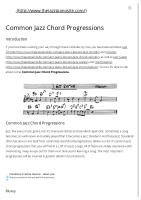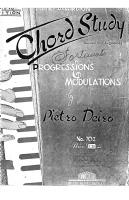4 Chord Progressions & Diatonic Harmony [PDF]
Chord Progressions & Diatonic Harmony A chord may be built upon any note of a musical scale, therefore a seven-note scal
33 0 82KB
Papiere empfehlen
![4 Chord Progressions & Diatonic Harmony [PDF]](https://vdoc.tips/img/200x200/4-chord-progressions-amp-diatonic-harmony.jpg)
- Author / Uploaded
- Israel Mandujano Solares
Datei wird geladen, bitte warten...
Zitiervorschau
Chord Progressions & Diatonic Harmony A chord may be built upon any note of a musical scale, therefore a seven-note scale allows seven basic chords, each degree of the scale becoming the "root" of its own chord.A chord built upon the note A is an A chord of some type (major/minor/diminished, etc.) The harmonic function of any particular chord depends on the context of the particular chord progression in which it is found. The diatonic harmonization of any major scale results in three major triads. They are based on the first, fourth, and fifth scale degrees (the tonic, subdominant and dominant. These three triads include, and therefore can harmonize, every note of that scale. The same scale also provides three relative minor chords, one related to each of the three major chords. These are based upon the sixth, second and third degrees of the major scale and stand in the same relationship to one another as do the three majors, so that they may be viewed as the first, fourth and fifth degrees of the relative minor key. Separate from these six common chords there is one degree of the scale, the seventh, that results in a diminished chord. In addition, extra notes may be added to any chord. If these notes are also selected from the original scale the harmony remains diatonic. If new chromatic intervals are introduced then a change of scale or modulation occurs, which may bring the sense of a change of tonal center. This in turn may lead to a resolution back to the original key, so that the entire sequence of chords helps create an extended musical form. Although all this allows for a large number of possible progressions , in practice, progressions are often limited to a few bars' length and certain progressions are favored above others: there is a certain amount of fashion in this and a chord progression may even define an entire genre. In western classical notation, chords built on the scale are numbered with Roman numerals. A D chord will be figured I in the key of D, for example, but IV in the key of A. Minor chords are signified by lower case Roman, so that D minor in the key of C would be written ii. Other forms of chord notation have been devised, from figured bass to the chord chart. These
usually allow or even require a certain amount of improvisation. This chapter will be devoted to learning how to create harmonies, but first we'll need to talk a bit about chord construction
Paul McCartney used an A-major I-IV-V7 chord-progression in,which is also an example of the twelve-bar blues.
An Introduction to Chord Construction & Music Theory You can construct chords by taking particular notes from a given scale. If, for example, you wanted to create a C major chord from the C major scale, you'd only have to know that the R, 3, and 5 of any major scale will form a major chord. You could say that the formula for a major chord is R, 3, 5. Take a look at the C major scale.
C D E F G A B (note name) 1 2 3 4 5 6 7 (degree)
Folowing our formula, a C major triad would be C (the root), E (the third), and G (the fifth) played simultaneously. Normally, all three notes would be in the same octave. C would the be lowest note, E would be next lowest, and G would be the highest note. This is what is called the "root position" of the chord. You can play chords which extend beyond one octave or in which the tones are not ordered in this way.Here's a C major triad in root position:
--0-- [Fifth, G] --2-- [Third, E] --3-- [Root, C] ----You could also play it with the root on the E string:
------5-- [5] --7-- [3] --8-- [R] Take a quick look at where the chord tones fall in a C major scale and you'll understand the challenge of playing chords on the bass. R=the root, C. The numbers represent scale degrees (2, 3, 4, 5, 6, 7):
|-6-|---|-7-|-R-| |-3-|-4-|---|-5-| |---|-R-|---|-2-| |---|---|---|---| 3 As you can see, in our typical C major pattern, the 3rd and 5th degrees are on the same string, so we can only sound one of them at a time in this pattern. There are several solutions. We can pick a pattern where we can play all three at once, we can omit one or more of the notes and imply the chord with what's remaining, or we can play one or more of the notes an octave higher or lower . It's generaly okay to leave out the five of any chord, so long as the chord doesn't specify a flat or augmented five (e.g. Cm7b5, or C#5). Most chords have a regular five, which is called a "perfect five." So long as the five is perfect, we can leave it out. In fact, it's the first to go. In the following example, I've left in the octave of the root because just playing the root and third can sound a little thin, and becuse I wanted a three note chord :
|---|---|---|-R-| |-3-|---|---|---| |---|-R-|---|---| |---|---|---|---| 3
If we move up the neck to the eighth fret, we can find a C root on the E string and can build a different kind of implied C major chord:
|---|---|-3-|---| |---|---|---|-R-| |---|---|---|---| |---|-R-|---|---| 8 This is, technically, a C major 10th . If you count the octave root as the 8th of the scale, then the note above that is the 9th and the note above that is, technically, the 10th.For our purposes, a C major chord is a C major chord no matter what octave the scales notes occupy, but sometimes it helps to know the difference. Chord Inversions You've probably noticed, in all of the chord examples above, that the root note is the lowest note of each chord. If you know your neck fairly well you might have noticed that you can sometimes find all three notes of the chord in a given possition if you were liberated from having to put C on the bottom. You can do this. Each chord can be "inverted." That is, it can be played starting on a note other than the root. You'll hear people speaking of chord "voicings" or of "voicing" a chord in a particular way, and these inversions are one of the things they may be refering to. The inversions, as you might have guessed, have names. Consider these three three chords :
Root Position (R, 3, 5) 5 |---|---|---|
1st Inversion (3, 5, R)
2nd Inversions (5, R, 3)
|---|---|---|---|
|---|---|---|---|
|---|-3-|---|
|-R-|---|---|---|
|-3-|---|---|---|
|---|---|-R-|
|-5-|---|---|---|
|---|-R-|---|---|
|---|---|---|
|---|---|-3-|---| 3
|---|-5-|---|---| 12
15
Understanding chord voicings give you a lot more options. The voicing of a chord will often be up to you. Some of these inversions aren't especially practical on the bass, but they're worth knowing anyway. The naming convention isn't very hard on this one. The first inversion starts on the 3rd, and the second inversion starts on the fifth. The lowest note is what determines the inversion. Whenever you play a third or a fifth instead of a root under someone else's chord, you are, in effect, causing it to sound like an inversion.
That's one of the strenghts of playing the bass. You can have a big effect on the chordal complexity of a song even just playing single notes. Minor Triads Now I'd like to show you some basic types of chords. Major triads (R, 3, 5) have already been explained in some detail. To get a minor triad, you flat the 3rd, which gives you R, b3, 5:
Root Position 5 |---|---|---|
1st Inversion
|---|---|---|---|
2nd Inversions
|---|---|---|---|
|b3-|---|---|
|-R-|---|---|---|
|b3-|---|---|---|
|---|---|-R-|
|-5-|---|---|---|
|---|---|-R-|---|
|---|---|---|
|---|b3-|---|---|
|---|---|-5-|---|
3
11
15
You could also play that 2nd inversion an octave down, at the 3rd fret. Augmented Triads An augmented triad is a major triad with a sharped fifth:
Root Position
1st Inversion
2nd Inversions
|#5-|---|---|
|---|---|---|---|
|---|---|---|---|
|---|-3-|---|
|-R-|---|---|---|
|-3-|---|---|---|
|---|---|-R-|
|---|#5-|---|---|
|---|-R-|---|---|
|---|---|---|
|---|---|-3-|---| 3
|---|---|#5-|---| 12
16
Diminished Triads A diminished triad is a minor triad with a lowered fifth:
Root Position b3|---|---|---|
1st Inversion
|---|---|---|---|
2nd Inversions
|---|---|---|---|
|---|---|b5-|
|---|-R-|---|---|
|b3-|---|---|---|
|---|-R-|---|
|b5-|---|---|---|
|---|---|-R-|---|
|---|---|---|
|---|---|b3-|---|
3
11
|---|b5-|---|---| 3
Major Seventh Chords We built major triads by starting on the root and progressing up the scale, picking every other letter (i.e. R, 3, 5). If we'd continued one note higher, we'd have had a major seventh chord (i.e. R, 3, 5, 7). Since seventh chords have four notes, they're challenging to play on the four-string bass, but if you know your theory, you can leave out certain notes and create beautiful voicings. Seventh chords can also be inverted, but since they're hard to voice in the first place, we'll just go with whatever is handiest and sounds best:
CMaj7 |---|-3-|---|---| |---|-7-|---|---| |---|---|---|---| |-R-|---|---|---| 8
Minor Seventh Chords To change a major seventh chord to a minor seventh chord, you flat the third and the seventh degrees:
Cmin7 |b3-|---|---|---| |b7-|---|---|---| |---|---|---|---| |-R-|---|---|---| 8
Dominant Seventh Chords If you take a major seventh chord, flat the seventh degree but leave the third alone, then you get what's called a dominant seventh chord (e.g. C7). This sound is very popular in jazz and blues. Here are two great voicings:
C7
C7
|---|-3-|---|---|
|---|---|---|---|
|b7-|---|---|---|
|---|b7-|---|---|
|---|---|---|---| |-R-|---|---|---| 8
|-3-|---|---|---| |---|-R-|---|---| 8
Half-Diminished Seventh Chords Another important seventh chord that you should know about is the half-diminished seventh, also called the "minor seven flat five." A min7b5 chord is, like the name says, a minor seventh chord with a flatted fifth degree. If you want to think of chord building with the Major seventh chord as a reference, then you could say a min7b5 chord is what you get when you take a Maj7 chord and flat the third, seventh, and fifth degrees. Here's an examples:
Cmin7b5 |b3-|---|---|---| |b7-|---|---|---| |---|b5-|---|---| |-R-|---|---|---| 8
Remember, They're Movable! If you commit to memory only one voicing of each chords I've presented in this section, you'll have learned eight different chords, all in C major. But if you know your neck and remember that these chords are all movable forms, you should be able to play each of these chords in all the other keys as well. For instance, to play all of these chords in D, you'd just need to use D as the root note of each chord. A quick clance at the neck diagrams will show you that D can be found on the fifth fret of the A string and on the 10th fret E string. Since there are twelve musical keys, you are well on your way to a very powerful knowledge of chords.









